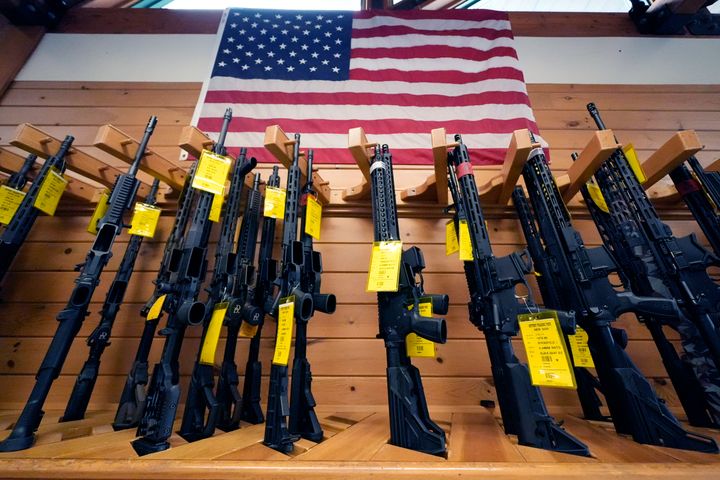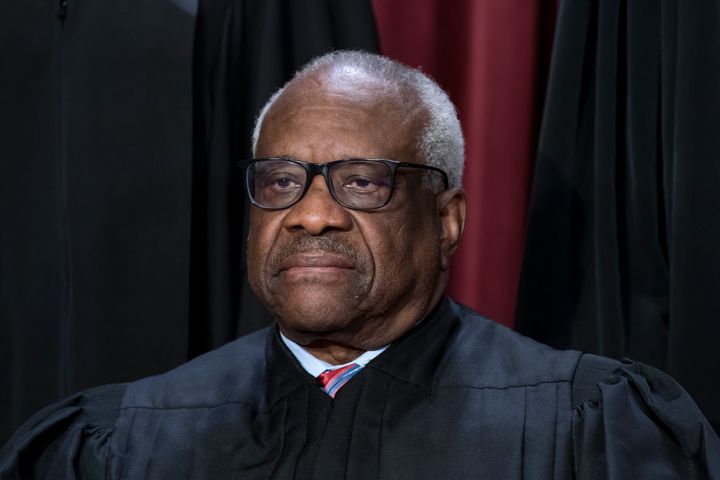When Justice Clarence Thomas penned a sweeping reinterpretation of the Second Amendment two years ago, it came as welcome news to opponents of assault weapons bans. Thomas’ ruling in the case of New York State Rifle and Pistol Association v. Bruen instructed lower courts to stop balancing the need for public safety against the right to bear arms.
Instead, the constitutionality of gun restrictions would depend only on whether a given law fit within a tradition of firearm regulation dating from between the signing of the Bill of Rights in 1791 and the end of the Civil War.
After Bruen, the Supreme Court vacated four lower court decisions upholding gun laws and sent them back for reconsideration under the new Second Amendment standard. One of them was a case challenging the constitutionality of Maryland’s assault weapons ban.
Gun rights groups had spent decades trying to win Second Amendment protections for semiautomatic rifles without success. With Bruen, they got a favorable ruling that opened a new line of attack on assault weapons bans. The flagship liberal response to the problem of mass shootings never looked so vulnerable. New Mexico legislators declined to even consider an assault weapons ban last year, fearing it would only get enjoined and overturned by a Supreme Court with a lopsided 6-3 conservative majority.
But two years after the seismic Bruen shift, assault weapons bans stand on unexpectedly sure footing.
The 4th U.S. Circuit Court of Appeals upheld that Maryland ban last week after the Supreme Court set the new gun rights standard in Bruen, handing reformers a major victory. Two other circuits have also declined to extend constitutional protections to so-called “assault rifles” — the semiautomatics with tactical cosmetic features favored by mass shooters.
Two of the judges who have recently voted to uphold assault weapons bans — Harvie Wilkinson III in the Maryland case and Frank Easterbrook in a case out of Illinois — are known as prominent conservative jurists and were both appointed by former President Ronald Reagan.
Without a circuit split, the Supreme Court faces little urgency to get involved. And one may never happen, given the fact that assault weapons bans are a blue-state phenomenon. No state in the notoriously conservative Fifth Circuit, for example, has an assault weapons ban on the books to challenge.
Though Justices Thomas and Alito have both said they want to consider whether semiautomatic rifles merit constitutional protection, the Court will first face more pressing questions that have already resulted in split decisions since setting the Bruen standard, like whether states can impose higher age restrictions on handgun purchases or whether some people with felony convictions can possess firearms.
And the Supreme Court’s most recent gun ruling United States v. Rahimi exposed a wide division between the Second Amendment absolutist Thomas and the rest of the court’s conservative majority — raising doubts that the high court would torch assault weapons bans even if it considered the question.
“There is strong reason to believe there is not a majority of five that thinks the Second Amendment means no state can ban assault weapons,” said Eric Tirschwell, executive director of Everytown Law. “The justices live in the same world we all live in. They see the way in which assault weapons have been used to carry out some of the most horrific mass shootings imaginable... It would not surprise me at all if the Court did not take this issue up any time soon, or ever.”
An Evolving Second Amendment Right
The Supreme Court has spent the last 16 years reshaping the right to bear arms. The text of the Second Amendment refers to the right to keep and bear arms specifically as part of a militia, an institution replaced more than a century ago by a professional military and National Guard.
But in 2008, the Supreme Court ruled in the case of District of Columbia v. Heller that individuals had a right to keep a loaded firearm in the home for self-defense. The case revolved around D.C. resident Dick Heller’s petition for a handgun permit and extended no specific protection to semiautomatic rifles. The ruling, penned by former Justice Antonin Scalia, did not apply to unusually dangerous weapons reserved for the military or commonly used by criminals, like machine guns or sawed-off shotguns. But it said protections would apply to weapons “in common use.”
Perhaps the biggest win for gun rights groups challenging assault weapons bans sprang directly from the Heller. Citing the still unspecified common use standard, District Judge Roger Benitez declared California’s restrictions on AR-15s unconstitutional three years ago.

“Like the Swiss Army Knife, the popular AR-15 rifle is a perfect combination of home defense weapon and homeland defense equipment... Yet, the state of California makes it a crime to have an AR-15 type rifle,” Benitez wrote in 2021. “Therefore, this Court declares the statutes to be unconstitutional.”
The 9th U.S. Circuit Court of Appeals blocked Benitez’s decision from taking effect, but the Bruen ruling required a new analysis. Benitez declared the law unconstitutional again last year. The 9th Circuit has so far blocked Benitez’s decision from taking effect and has left the case pending while it considers the constitutionality of California’s magazine restrictions.
Gun groups have continued to press the same argument that resonated with Benitez in the growing number of challenges to assault weapons bans. Production figures indicate that Americans own roughly 28.1 million modern semiautomatic rifles for recreational shooting, hunting and self-defense, according to Mark Oliva, spokesman for the National Shooting Sports Foundation, the industry trade group. That figure is higher than the number of Ford F-150s on American roads.
“These are by any stretch of the definition commonly owned, commonly used, typically possessed firearms,” Oliva told HuffPost.
Bruen appeared to bolster that argument. Not only are AR-15s and AK-47s widely possessed, but states would now have to show that banning that class of weapons fits within a historical tradition.
Last week’s ruling from the 4th U.S. Circuit Court of Appeals laid out the emerging legal defense for assault weapons bans in an era of expanding Second Amendment rights. Assault rifles, the 15-judge panel ruled by a vote of 10-5, are not protected by the Second Amendment because they are “ill-suited and disproportionate to the need for self-defense” — and the Heller standard only gives individuals the right to bear arms in order to defend themselves. That generally means sticking with handguns, according to the 4th Circuit ruling.
Congress has historically restricted several classes of dangerous firearms, the ruling noted. The National Firearms Act of 1934 restricts sawed-off shotguns, short-barreled rifles and machine guns. Civilians generally cannot buy machine guns or conversion devices manufactured after 1986.
“Our nation has a strong tradition of regulating excessively dangerous weapons once it becomes clear that they are exacting an inordinate toll on public safety and societal wellbeing,” the ruling says, later adding: “The Second Amendment, with its ‘central component’ of ‘individual self-defense,’ is not concerned with ensuring citizens have access to military-grade or gangster-style weapons.”
The ruling disputes that the Heller standard means that, once a gun is in common use, states can no longer ban it. Instead, the ruling contends that the Heller standard only means that the Second Amendment does not specifically protect weapons that civilians rarely possess.
“We decline to hold that arms manufacturers can secure constitutional immunity for their products so long as they distribute a sufficient quantity before legislatures can react,” the ruling reads.
The Firearms Policy Coalition, a plaintiff in the Maryland lawsuit, described the 4th Circuit’s ruling as “incredibly flawed” in an email, contending that it “begs for review as it ignores the text of the Constitution, [flouts] the Supreme Court’s binding precedents, and ignores relevant history.”
“FPC will take the Fourth Circuit’s terrible decision to the Supreme Court without delay,” the group’s president, Brandon Combs, said in a press release. “Our objective is simple: End all bans on so-called ‘assault weapons’ nationwide.”
An Isolated Justice

Justices Clarence Thomas and Samuel Alito have both expressed interest in clarifying what weapons qualify for Second Amendment protection, with Thomas referring to a 7th U.S. Circuit Court of Appeals decision upholding an Illinois assault weapons ban as “highly suspect.”
But Thomas no longer appears to guide the Supreme Court’s thinking on the Second Amendment.
After he dropped the Bruen bombshell, courts across the country reached disparate conclusions about the constitutionality of longstanding gun restrictions. The first one to come before the Supreme Court was the case of United States v. Rahimi out of Texas.
Zackey Rahimi had allegedly beaten and threatened the mother of his child with a firearm, leading a judge to place him under a protective order for domestic violence that made it a federal felony to possess firearms. While under that order, Rahimi allegedly fired guns at four separate people. When police searched his home in connection with the string of shootings, they found a semiautomatic rifle under his bed and a pistol with an extended magazine on a bedside table.
Thomas was the only justice to conclude that the federal government had violated Rahimi’s Second Amendment rights by convicting him for possessing guns under the protective order, exposing an unforeseen chasm between his Second Amendment absolutism and the rest of the court.
“The other eight justices severely rebuked him on the Second Amendment,” Douglas Letter, chief legal officer at Brady United, said of Thomas. “I’ve talked to a bunch of other constitutional scholars, and none of us can think of a decision where, a mere two years later, that justice loses 8-1 on the meaning of his own opinion.”
For now, the Supreme Court will likely let Second Amendment litigation play out in the lower courts — probably for years.
“I think it would make sense for the court to take time for Rahimi to shake out,” said Shira Feldman, director of constitutional litigation at the gun violence prevention group Brady United. “Rahimi made really important clarifications to the Bruen test.”
Those following the issue will be watching challenges in Illinois and Delaware, both of which lie in circuits without a sharp liberal bent. The 9th U.S. Circuit Court of Appeals is also expected to rule this year on the case that started before Judge Benitez in California. And there is a chance, however small, that the Supreme Court will decide to review last week’s ruling on the Maryland assault weapons ban.
Most observers, however, expect the court to leave the question alone — at least for now.
“I don’t think this is something that’s going to be taken up this year,” said Oliva, the NSSF spokesman. “But these things just continue to circle the drain in the lower courts ad nauseam. Eventually, the Supreme Court is going to look at one of these that percolates up to their level.”
Disclaimer: The copyright of this article belongs to the original author. Reposting this article is solely for the purpose of information dissemination and does not constitute any investment advice. If there is any infringement, please contact us immediately. We will make corrections or deletions as necessary. Thank you.
